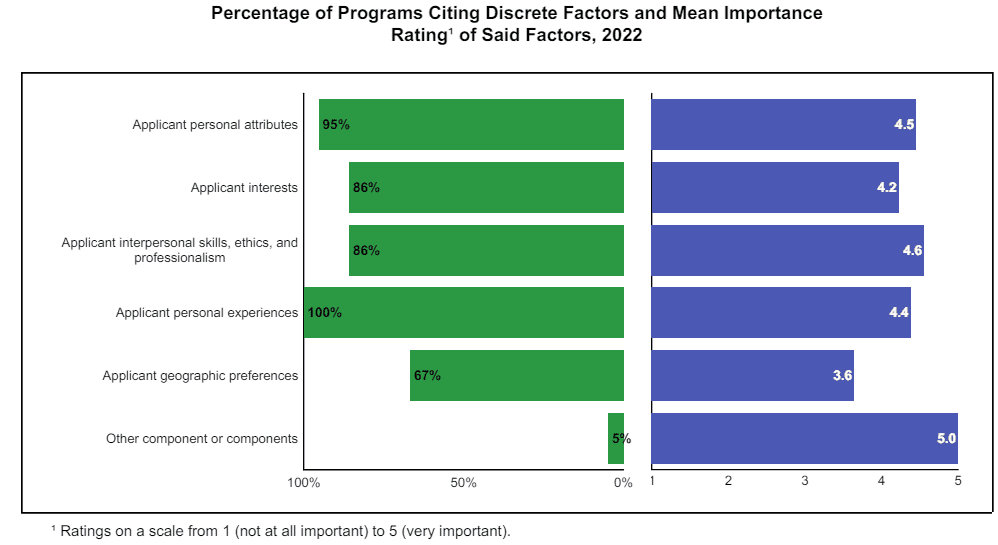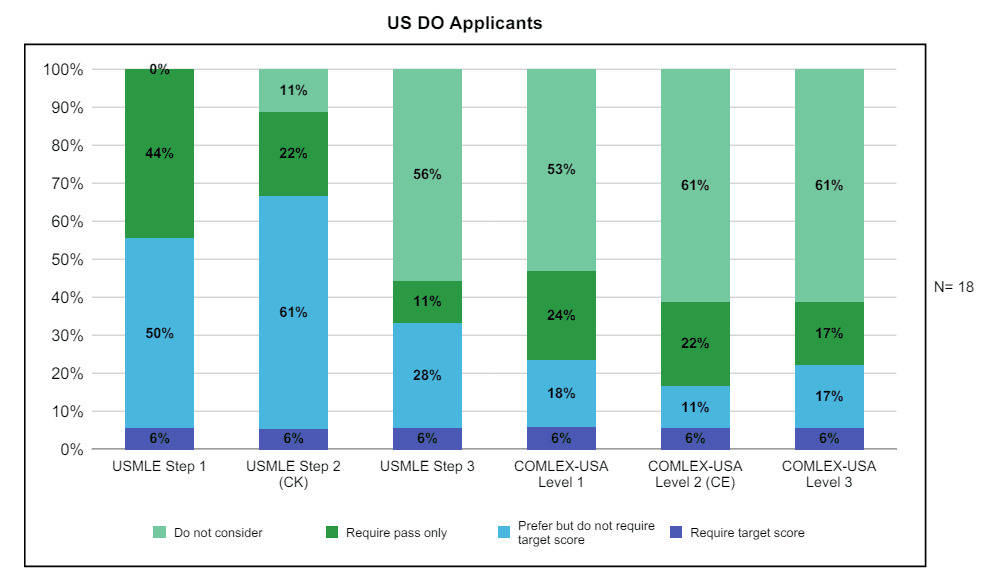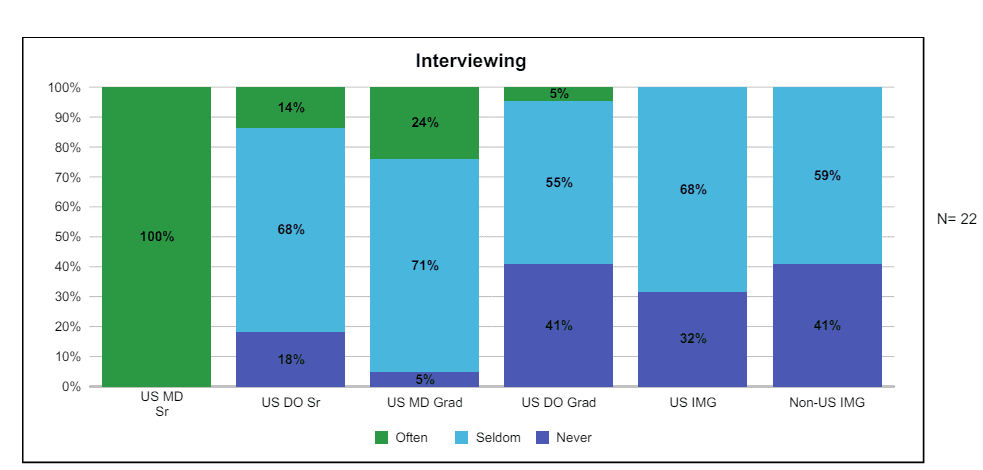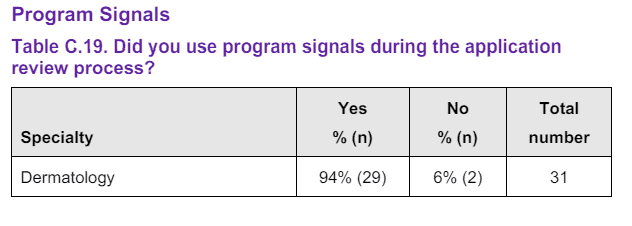How to Match into a Dermatology Residency Program in 2025

22251 Views
What You Need to Match into Dermatology Residency
Matching into a Dermatology program for residency is no small feat. Luckily, the NRMP conducts a biennial survey of program directors across all programs participating in the main residency Match. This survey serves to share what directors consider when deciding which candidates to interview and rank for their residency program. The most recent 2022 survey solicited information on:
- Breakdown number of applications received, screened, and reviewed, as well as the number of applicants interviewed and ranked
- Frequency with which programs interview and rank specific applicant groups
- Current approach and future outlook for virtual application and selection process
- Use of test scores in considering which applicants to interview
- Factors used for both interview selection and for ranking applicants, particularly with engaging in a “holistic review”
Additionally, NRMP releases a biennial report analyzing characteristics of applicants who successfully match to their preferred specialty. Characteristics measured include:
- Number of contiguously ranked programs in preferred specialty
- USMLE Step 1 and Step 2 CK scores, and COMLEX Level 1 and Level 2-CE scores (for U.S. DO seniors)
- Numbers of research experiences, publications, and work and volunteer experiences.
Links to the latest Match data and reports can be found on the NRMP website here https://www.nrmp.org/match-data-analytics/residency-data-reports/. In order to help you on your journey to a successful dermatology match, we’ve highlighted the key points for dermatology below.
*Of note, although the program director survey was sent to 128 dermatology program directors, response rates were limited (22.7%) so these results are based on N=29*
For Dermatology residency specifically, major areas you should pay attention to include:
Holistic Review: What factors are considered
There’s a growing push to consider the whole applicant, not just their scores. Amongst factors listed, 100% of program directors in the 2022 survey indicated consideration of an applicant’s personal experiences when conducting holistic review. A majority also included personal attributes, interests, interpersonal skills/ethics/and professionalism as important factors they consider.
Figure 1: Percentage of Dermatology Programs Citing Discrete Factors in Holistic Review and Mean Importance Rating’ of Said Factors – from the NRMP Program Director Survey 2022
Standardized Testing Scores are still an important part of the review process
Step 1’s pass/fail switch led to removing numeric score questions from the program director survey. Nonetheless, the majority of program directors still indicate consideration ofUSMLE performance in the applicant selection process for interviews. 100% of program directors in the 2022 survey considered Step 1 performance during review of US applicants.
For DO candidates, COMLEX scores were not considered as much as their USMLE counterparts.
Figure 2: Percentages of Dermatology Programs Using USMLE to Select US MD Applicants for Interview – from the NRMP Program Director Survey 2022
Figure 3: Percentages of Dermatology Programs Using USMLE to Select IMG Applicants for Interview – from the NRMP Program Director Survey 2022
Figure 4: Percentages of Dermatology Programs Using USMLE and COMLEX-USA to Select DO Applicants for Interview – from the NRMP Program Director Survey 2022
Note: At time of survey, a proportion of the past cycle’s applicants did have a step 1 numeric score, hence some programs still requiring a target score
NRMP match data on successful applicants from prior cycles can also provide insight into a general range of scores to aim for to be amongst the average dermatology applicant.
| US MD | US DO | IMG * | ||||
| Matched | Un- matched | Matched | Un- matched | Matched | Un- matched | |
| Mean USMLE Step 2 score | 257 | 251 | 256 | 247 | 252 | 241 |
| Mean COMLEX Level 1 score | n/a | n/a | 626 | 619 | n/a | n/a |
| Mean COMLEX Level 2 score | n/a | n/a | 681 | 638 | n/a | n/a |
*Table derived from NRMP reports for Charting Outcomes in the Match, 2022*
Of note, the mean scores between matched and unmatched applicants, particularly amongst US MDs, are not drastically different – suggesting the role of other factors in the holistic review that can set successful applicants apart.
Nevertheless, failing a standardized exam is a big deal for any specialty, and this is especially relevant in a highly competitive specialty like dermatology. If you have failed an exam, you should apply broadly to a number of programs and do proper research to see which programs may value other aspects of your application more greatly during holistic review.
Types of Applicants Considered
- International Grads (U.S. and non-U.S.) are more likely to have difficulty matching into Dermatology: Based on the most recent program director survey, 68% consider U.S. IMGs seldom, and 32% never consider a U.S. IMG for an interview or rank. If you are a non-US IMG, the chances are even lower, with nearly 41% of programs reporting never considering non-US IMG applicants. The percentage of seldom interviewing or ranking are higher than previous surveys from 2020, however chances are still slim. We recommend doing your homework to determine which programs may be more likely to consider IMGs, and determining a back-up specialty to apply into.
- Osteopathic seniors may have difficulty matching into Dermatology: Few programs regularly interview and rank DO applicants. 18% of programs will never interview a DO applicant in their senior year of medical school, and 41% will never interview a DO applicant who has already graduated. With the remaining portion that seldom consider DO applicants, it is very important to do your research to identify these programs so that you can best increase your chances of matching.
Figure 5: Percentages of Programs Interviewing Candidates by Applicant Type – from the NRMP Program Director Survey 2022
Figure 6: Percentages of Programs Ranking Candidates by Applicant Type – from the NRMP Program Director Survey 2022
Preference an Geographic Signaling
Geographic Signaling
Geographic signaling allows applicants to indicate their preference for training in specific geographic regions. Preference Signaling refers to applicants sending a limited number of “signals” to residency programs to indicate their high level of interest. Since the introduction of geographic and preference signals in the 2022-2023 Match cycle, the system has gone through a few changes as programs and applicants figure out how to best utilize this feature. An AAMC survey of program directors (https://www.aamc.org/media/64996/download) characterized how these signals have been used on the program’s side. Of note, the survey received 36 responses of 129 dermatology program directors.
Regarding geographic signaling, the majority of programs (81%) used geographic signaling at some point during the application review process. Of those who used the geographic signal, 83% of respondents used it as a screening tool, 58% as part of a holistic process to help decide who to interview, 96% used it as a tiebreaker when deciding who to interview. 67% indicated that the geographic preference helped identify applicants who would otherwise be overlooked.
Figure 7: Percentages of Programs Using Geographic Preference Signals During Application Process – from the AAMC Program Director Reaction Survey for the 2023 Application Cycle
Program Signaling
Regarding preference signaling, 94% of respondents considered preference signals during the application process. Of those who used the signals, 82% of respondents used it as a screening tool, 96% as part of a holistic process to help decide who to interview, 96% used it as a tiebreaker when deciding who to interview. 86% indicated that the program preference helped identify applicants who would otherwise be overlooked. Of note, only 46% agreed that applicants who signaled their program were better aligned than those who did not.
Figure 8: Percentages of Programs Using Program Signals During Application Process – from the AAMC Program Director Reaction Survey for the 20223 Application Cycle
We recommend selecting your geographic and preference signals based on your true preferences. There is no guarantee that you will get an interview at every place that you signal. However, it may be one more factor in the holistic review process for the program to take a closer look at your application.
Summary for Dermatology Residency Applications
- Most successfully Matched applicants pass Step 1 on their first attempt and record a Step 2 score of 250+
- In promoting a more holistic approach to the residency selection process, programs place importance on an applicant’s personal experiences and attributes.
- Many programs take into account geographic and preference signals when making interview and ranking decisions.
- Dermatology does not historically match many IMG or DO candidates. However, it is possible to match if you establish proper connections. Doing your research to identify programs with a history of accepting IMG and DO residents can help as well.
- If you’ve failed a USMLE or COMLEX exam, you can still apply in Dermatology, but you should apply very broadly and consider applying for a back-up specialty.
- Expect to receive the majority of interview invites on scheduled release dates (usually in November) and to schedule most interviews between November and January.
Good Luck!
Wondering about your chances of matching into other specialties for residency? Check out our analysis of the NRMP directors survey “at a glance” tool for areas including anesthesia, neurology, family medicine, transitional year, psychiatry, emergency medicine, and more under the Residency Applications category of our blog! If you need further or specialized assistance understanding which residency specialties you are best suited to apply to, you can contact us or visit our residency advising page to learn more about how Elite Medical Prep residency advising services can help you.
Featured Articles










